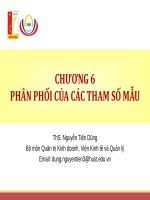Lectures Marketing management: Chapter 10 - ThS. Nguyễn Tiến Dũng
Bạn đang xem bản rút gọn của tài liệu. Xem và tải ngay bản đầy đủ của tài liệu tại đây (708.52 KB, 23 trang )
CHAPTER 10
CRAFTING BRAND EQUITY
Nguyen Tien Dung, MBA
Email:
Chapter Questions
● How can a firm develop and establish an
effective positioning in the market?
● How do marketers identify and analyse
competition?
● How are brands successfully differentiated?
● What are the differences in positioning and
branding with a small business?
© Nguyễn Tiến Dũng
2
Main Contents
1. Developing and Establishing a Brand
Positioning
2. Differentiation Strategies
3. Positioning and Branding a Small Business
© Nguyễn Tiến Dũng
3
1. Developing and Establishing a Brand Positioning
● Determining a Competitive Frame of
Reference
● Identifying Optimal Points-of-Difference and
Points-of-Parity
© Nguyễn Tiến Dũng
4
Determining A Competitive Frame of Reference
© Nguyễn Tiến Dũng
5
Determining A Competitive Frame of Reference
● Identifying Competitors
● Analyzing Competitors
© Nguyễn Tiến Dũng
6
● Four crucial questions for marketers to create value
innovation by Kim and Mauborgne (Blue Ocean Strategy)
1. Which of the factors that our industry takes for granted
should we eliminate?
2. Which factors should we reduce well below the industry’s
standard?
3. Which factors should we raise well above the industry’s
standard?
4. Which factors should we create that the industry has
never offered?
● All three platforms on which value innovation can take
place: physical product; service including maintenance,
customer service, warranties, and training for distributors
and retailers; and delivery (channels and logistics).
© Nguyễn Tiến Dũng
7
Analyzing Competitors
© Nguyễn Tiến Dũng
8
Identifying Optimal Points-of-Difference and Points-ofParity
● Points-of-Difference
● Points-of-Parity
© Nguyễn Tiến Dũng
9
Points-of-Difference
● Examples:
● Apple (design, ease-of-use, and irreverent attitude),
● Nike (performance, innovative technology, and
winning),
● Southwest Airlines (value, reliability, and fun
personality).
● Choose a brand association as a point of
difference
● Desirable to consumer
● Deliverable by the company
● Differentiating from competitors
© Nguyễn Tiến Dũng
10
Points-of-Parity
● Attribute or benefit associations that are not
necessarily unique to the brand but may in
fact be shared with other brands.
● Category points-of-parity are attributes or
benefits that consumers view as essential to
a legitimate and credible offering within a
certain product or service category.
● Competitive points-of-parity are associations
designed to overcome perceived
weaknesses of the brand.
© Nguyễn Tiến Dũng
11
Perceptual map
© Nguyễn Tiến Dũng
12
Brand Mantras
● A brand mantra is an articulation of the heart and soul of
the brand and is closely related to other branding
concepts like “brand essence” and “core brand promise.”
● Three key criteria:
● Communicate. A good brand mantra should define the
category (or categories) of business for the brand and set the
brand boundaries. It should also clarify what is unique about
the brand.
● Simplify. An effective brand mantra should be memorable. For
that, it should be short, crisp, and vivid in meaning.
● Inspire. Ideally, the brand mantra should also stake out ground
that is personally meaningful and relevant to as many
employees as possible.
© Nguyễn Tiến Dũng
13
● Authentic athletic performance
© Nguyễn Tiến Dũng
14
Establishing Brand Positioning
© Nguyễn Tiến Dũng
15
Establishing Brand Positioning
● Communicating category membership
● 1. Announcing category benefits
● 2. Comparing to exemplars
● 3. Relying on the product descriptor
● Communicating POPs and PODs
© Nguyễn Tiến Dũng
16
2. Differentiation Strategies
● Means of differentiation
● Rational versus Emotional branding
© Nguyễn Tiến Dũng
17
Means of differentiation
Product
Differentiation
Service
Differentiation
Channel
Differentiation
© Nguyễn Tiến Dũng
Employee
Differentiation
Image
Differentiation
18
Emotional Branding
● Brands that are lovemarks, according to Roberts,
command both respect and love
● Love marks result from a brand’s ability to achieve
mystery, sensuality, and intimacy
● Mystery draws together stories, metaphors, dreams, and
symbols. Mystery adds to the complexity of relationships
and experiences because people are naturally drawn to
what they don’t know.
● Sensuality keeps the five senses of sight, hearing, smell,
touch, and taste on constant alert for new textures,
intriguing scents and tastes, wonderful music, and other
sensory stimuli.
● Intimacy means empathy, commitment, and passion. The
close connections that win intense loyalty as well as the
small perfect gesture.
© Nguyễn Tiến Dũng
19
● In general, the firm should monitor three
variables when analyzing potential threats
posed by competitors:
● 1. Share of market—The competitor’s share of the
target market.
● 2. Share of mind—The percentage of customers
who named the competitor in responding to the
statement,“Name the first company that comes to
mind in this industry.”
● 3. Share of heart—The percentage of customers
who named the competitor in responding to the
statement,“Name the company from which you would
prefer to buy the product.”
© Nguyễn Tiến Dũng
20
Alternative Approaches to Positioning
© Nguyễn Tiến Dũng
21
● Brand narratives and storytelling
● Brand journalism
● Cultural branding
© Nguyễn Tiến Dũng
22
3. Positioning and Branding a Small Business
● Creatively conduct low-cost
marketing research
● Focus on building one or two
strong brands based on one or
two key associations
● Employ a well-integrated set of
brand elements
● Create buzz and a loyal brand
community
● Leverage as many secondary
associations as possible
© Nguyễn Tiến Dũng
23









